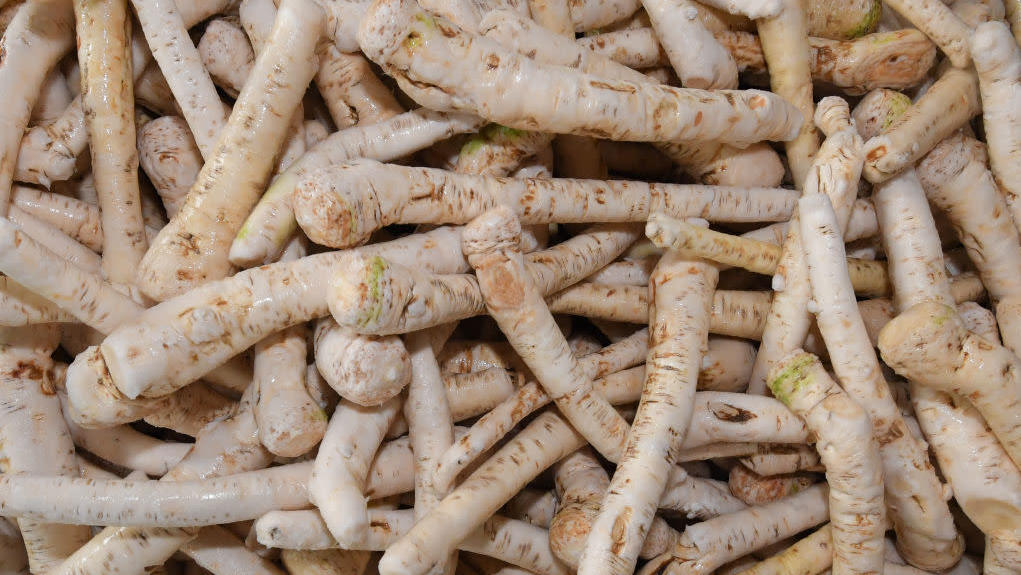What Makes Horseradish Spicy?
Recently, I've been on a massive horseradish kick. I got a squeeze bottle of Beano's Heaveny Horseradish Sauce for sandwiches (no, not the fart pill Beano), and I've been going to town on it. Most horseradish spreads or sauces I've ever had were really weak, but to my surprise, Beano's version kicks my ass. I can't get enough of it.
The first bite I think, "Oh, I can handle thi—" followed quickly by, "Oh, shit!" That's when the sheer nasal-clearing fury of the horseradish kicks in. For about half a second I curse myself for flying too close to the sun, but when the pain quickly subsides, I rush in for another bite. This leaves me with a lot of questions. I've recently come to realize that I have no idea what makes this radish kick you in the face like a horse (see what I did there?).
I asked Subha Ranjan Das, an Associate Professor of Chemistry at Carnegie Mellon University, and a long time Twitter friend, to help me answer the question of what makes horseradish punch you in the nasal cavity. Let's deploy some science!
What makes horseradish spicy?
Horseradish is spicy (or pungent) because of a family of compounds called isothiocyanates. Allyl isothiocyante is the predominant "spicy" or pungent compound in mustard, horseradish, wasabi, and other crucifers, or the Brassicaceae family of plants (so, yes, in Brussels sprouts too!).
In the cells of these plants, there is an enzyme, myrosinase, that is kept nicely apart from the glucose molecules, or glucosinolates, as the plant is growing in the ground. But when the tissue of the plant is damaged—say, when you slice into it or grate it while cooking—the myrosinase breaks down the glucosinolates, producing those pungent, spicy isothiocyanates that make our noses run.
All of these isothiocyantes contribute to the activation of the body's nociceptors, aka the neurons responsible for alerting us to harmful or noxious stimuli. (The isothiocyanate is actually the plant's defense against pests, so this makes sense.) When our nocireptors are activated, the body is being sent signals along the same receptors that convey pain and heat. That's why the spiciness also feels like heat, even in our noses.
Is the “spiciness” in horseradish the same as what’s in wasabi? Is there a difference between the two root vegetables?
The spiciness of horseradish is almost the same as in wasabi, because wasabi is also in the plant family Brassicaceae. Besides some slight flavor compound differences, wasabi has a higher percentage of allyl isothiocyanate. This means that it's more volatile and, consequently, more fleeting as a feeling of pain and/or heat. Even if you eat a large amount of wasabi in one go, its spice level will dissipate quicker after you eat it. Horseradish's kick sticks around a bit longer because it has other less volatile isothiocyanates (in higher proportions). Otherwise, the spiciness of wasabi and horseradish are taking all the same actions on your pain receptors, and lingering in the nose.
Is this heat comparable to hot peppers (capsaicin), or is this a completely different beast?
The spiciness we feel when we eat capsaicin is happening along the same pain receptors that react to horseradish, so the signal we feel is similar: pain and/or heat. But capsaicin is a different type of molecule, and it stays on the tongue. It isn't very volatile, so the heat lingers differently. (Things like cinnamon and black pepper also have molecules that can act on the receptors to send "spicy" signals to the brain.)
What’s the best way to temper the heat of horseradish if it’s too intense?
Horseradish heat is intense based on amount (bigger bite = bigger burn), but the good news is that the burning/heat sensation should be fleeting. The enzyme can be degraded by heat: after all, cooked Brussels sprouts aren't pungent, and horseradish isn't spicy either if you boil it and/or heat it with milk or cream. Acid stabililzes isothiocynates, which is why prepared or grated horseradish is kept in vinegar. So adding baking soda is an alternate solution to degrade and dissipate the isothiocyanates.
There you have it, everyone. The spiciness comes from compounds called isothiocyanates in conjunction with an enzyme called myrosinase, which in turn causes my Beano's Heaveny Horseradish Sauce to give me such masochistic joy. Of course, out of curiosity, I had to ask Das if you could weaponize horseradish. I play a lot of video games and think about stuff like this more often than most people would consider healthy.
His response: "Dangerous? Well, depends how you use it and in what quantities." Then he sent me this link. Psst. The answer is yes.
